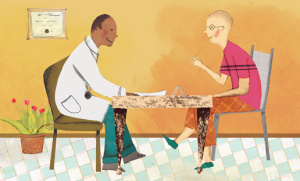Cultural differences and the doctor-patient relationship
Medical Pharmaceutical Translations • Jun 1, 2015 12:00:00 AM

When I first saw my new GP’s examining room, I gasped in grateful surprise. Unlike my previous doctor’s office, this one looked clean and new, with freshly painted walls decorated with pleasant artwork. If you live in the US, this may sound standard to you, and that’s exactly my problem; although France is known for its excellent medical care, the combination of French pragmatism and a lower budget means that doctors’ offices are often hygienic but unwelcoming environments. It shouldn’t matter, but it does, at least a bit, when you’re coming from a culture that has a much more “customer service”-oriented mentality.
It turns out I’m not the only American who’s been put off by drab doctor’s offices and, often, practitioners’ brusqueness, as this guide attests. My experience got me wondering about other situations where culture influences doctor’s visits.
A quick internet search yields a bevy of examples. Two that I find especially interesting are featured in an article I’d come across and cited it in another, unrelated post for this blog. It’s an excellent read for anyone interested in how language and culture can be challenging for doctors and patients.
One case that author David Cameron describes is that of a Haitian man who would regularly visit the ER complaining of symptoms like sleeplessness, anxiety, and weight loss. No matter how many times he was examined, doctors couldn’t give him a diagnosis. One day, the man’s mother said it was because her son had been hexed by a witch doctor and that only another witch doctor could break the spell. Dr. Douglas Kelling did as she’d advised: the next time the man came to the ER, he had a witch doctor from the local Haitian community visit with him. Whatever was done, the man’s symptoms disappeared.
Whether you share the man and his mother’s beliefs, or know how much the mind can influence physical health – or both – it’s great that Dr. Kelling was able to respect this patient’s culture enough to work with it, finding a solution that ultimately healed him.
Another example in the article is the case of New Mexico-based Dr. Sonya Shin, who trains medical professionals to work with patients from the Navajo Nation. In Navajo culture, words themselves have power. This means, for example, that if a doctor tells a patient what could happen to them if they don’t take their medication, the patient may perceive this as the doctor bringing it upon them. Talking about palliative care is also difficult; the Navajo don’t speak about death.
Unfortunately, cultural differences between doctor and patient aren’t just interesting details that both parties can usually get past; according to this article in the New York Times, treatment plans are dramatically less likely to be followed by people from certain cultures unless their physician – or the interpreter working with them – can explain things in a way that addresses what can be a very different approach to medicine.
There are various possible solutions to overcoming these differences, like a physician and/or interpreter taking time to briefly learn about a patient’s cultural relationship to medicine. But this may not always be possible. The best advice seems to be this, from Dr. Arthur Kleinman: “both sides should be aware of [cultural differences] and be able to reflect on [them] in a self-critical way.” Both doctors and patients should also be open to adapting to the other person’s culture, like doctors did in allowing the Haitian patient’s family to call on a witch doctor. These suggestions may sound like common courtesy, but they could, ultimately, mean the difference between life and death.
#culture #relationship #language #patienteducation #physician #aiatranslations #patient
